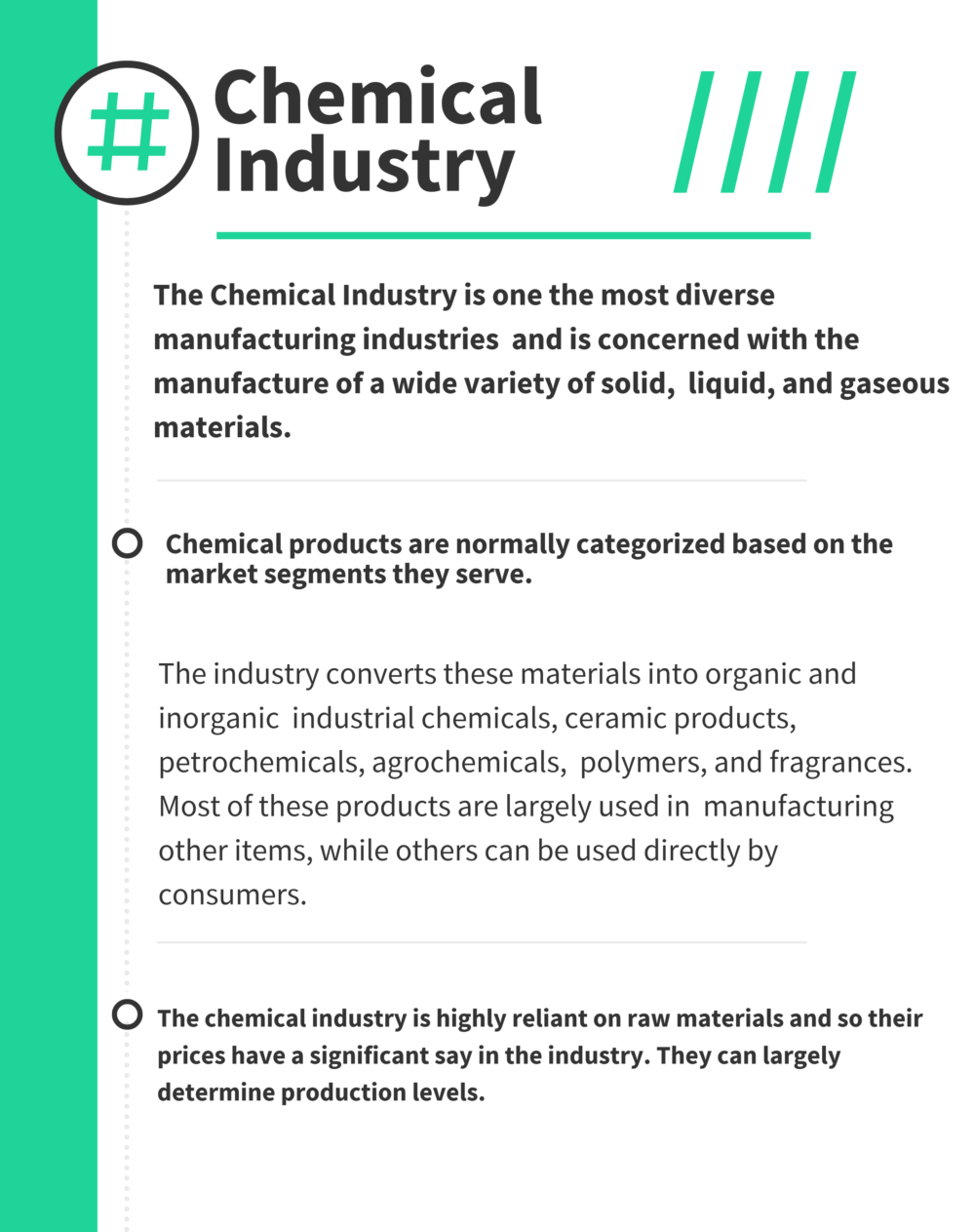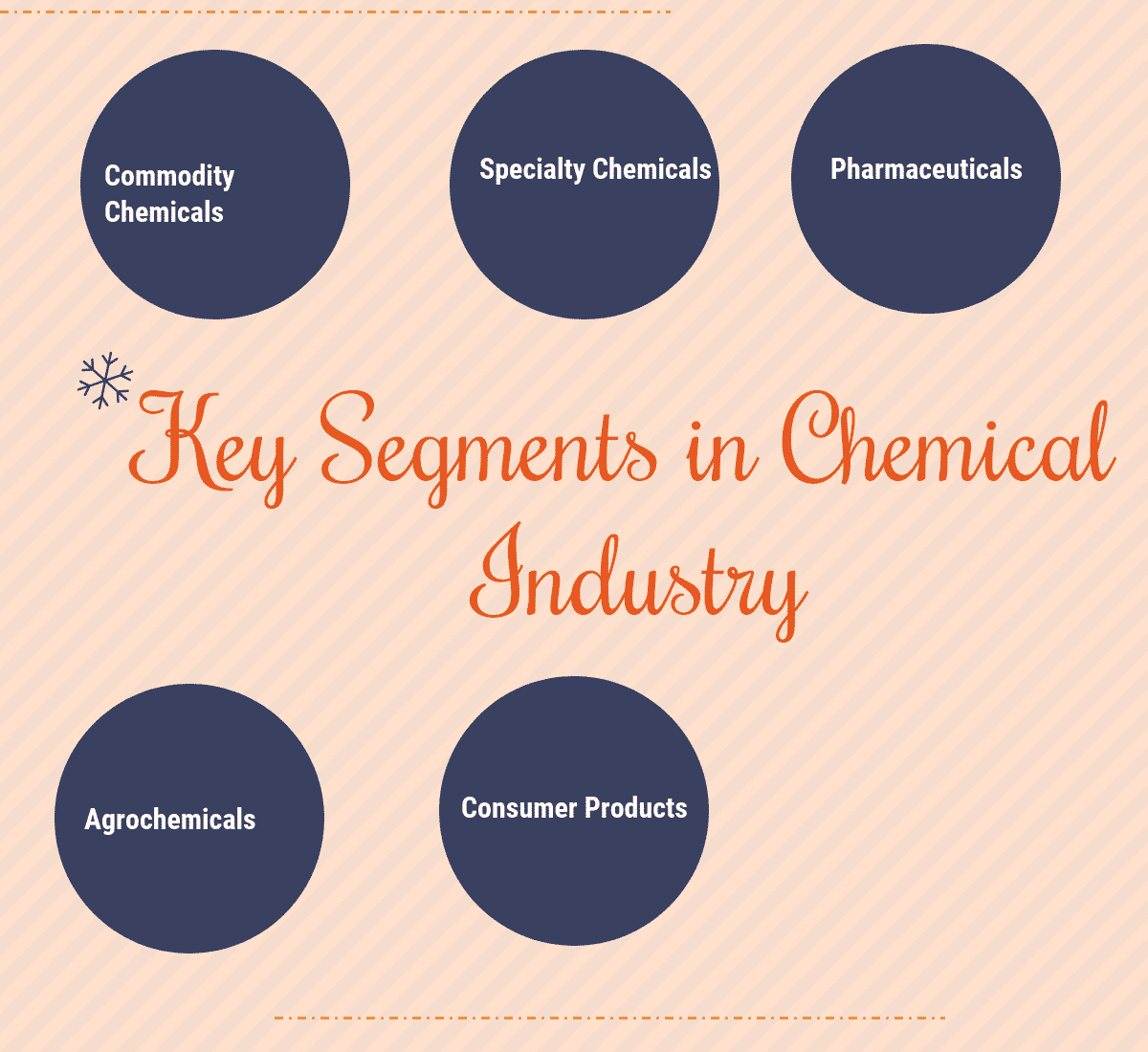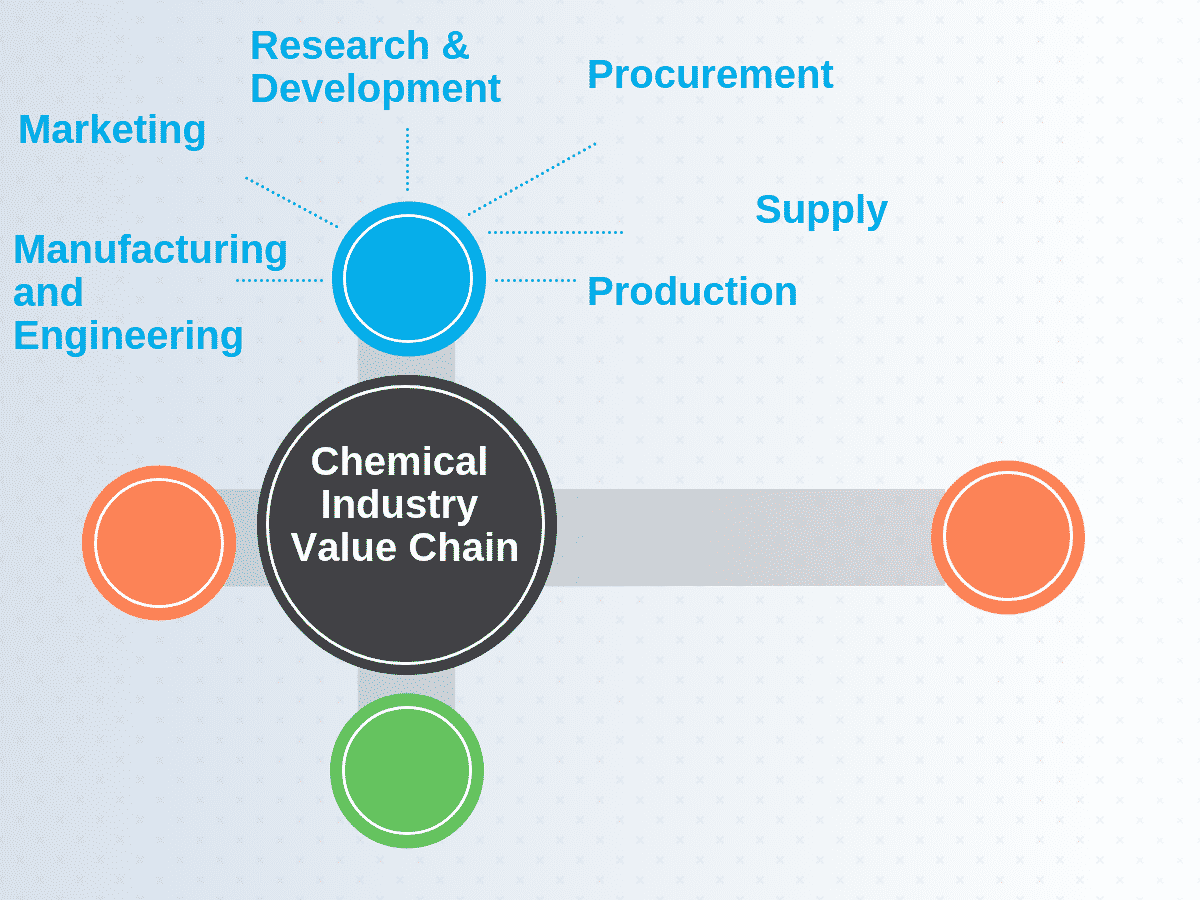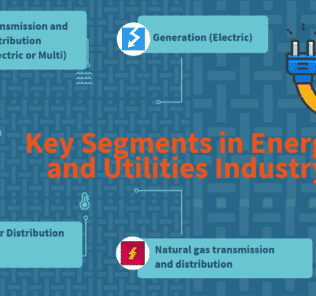All About Chemical Industry: Key Segments and Value Chain

The Chemical Industry is one the most diverse manufacturing industries and is concerned with the manufacture of a wide variety of solid, liquid, and gaseous materials. The main raw materials of the chemical industry are water, air, salt, limestone, sulfur, and fossil fuel.
The industry converts these materials into organic and inorganic industrial chemicals, ceramic products, petrochemicals, agrochemicals, polymers, and fragrances. Most of these products are largely used in manufacturing other items, while others can be used directly by consumers.
The chemical industry is highly reliant on raw materials and so their prices have a significant say in the industry. They can largely determine production levels. For instance, the chemical industry is growing rapidly in the Middle East, where cheap petrochemical raw materials are available. Production costs also play a huge role in how the industry operates. The Asian continent for example, where labor is readily available and so labor costs are relatively low, has experienced significant growth in the industry.
As history shows, the chemical industry has been synonymous with Western Europe and North America. Europe, in particular, has, for a long time, remained the largest producer of chemical products followed by the US and Japan. However, according to statistics by Statista, an online statistics portal, the Asia/Pacific region has taken over the industry with domestic chemical sales in the region reaching 2.79 trillion US dollars in the year 2016. The statistics, which outline the total value of all domestic sales of chemicals worldwide based on region, Asia/Pacific was by far ahead of other regions in terms of on chemical sales.
So, what could have changed? You may ask. Well, research shows that companies in the chemical industry are becoming increasingly aware that the future of this industry will look very different from how it does today. For that reason, they have sought to integrate green product design principles in their manufacturing processes to drive growth. They are also investing a lot of resources in cleaner modes of production and also in research and development.
This allows them to produce profoundly safer products and which, as a result, appeal to consumers. Additionally, in a country like Germany, companies are now based in the country’s numerous chemical parks, which provide exceptional infrastructure, together with an interconnected system of raw materials and energy, enabling companies based in these parks to remain competitive in their production. This has made the country one of the world’s largest exporter of chemical products.
Lastly, companies looking for new marketing platforms are redesigning their product portfolios so as to adjust to new demand scenarios. This is what companies in this industry should or need to do, or risk being phased out of this lucrative industry.
What are the Key Segments in Chemical Industry?
Chemical products are normally categorized based on the market segments they serve. As mentioned earlier some chemical products are used to manufacture other products while some are ready-made to be consumed directly by end-users. Here is a list of the key segments of the chemical industry.

What are the Key Segments in Chemical Industry
- Commodity chemicals: These are chemicals that are solely categorized on the basis of their chemical composition. In fact, their composition is universal and one supplier’s commodity chemical product can be readily interchangeable with that of another. Commodity chemicals comprise a huge portion of the chemical industry with their global market valued at approximately $908 billion. Examples are polymers, plastics, synthetic fibers, and petrochemicals. They are used to make such products as furniture, home décor, prosthesis, PVC piping, water tanks, and electronics.
- Specialty chemicals: Unlike commodity chemicals, specialty chemicals are sold on the basis of their functional performance rather than their chemical composition. This means that they are categorized in terms of how much they influence the performance and functionality of end products. Specialty chemicals make up approximately 35% of the entire industry’s output. They are highly useful in the manufacture of electrical and electronic products, industrial and home cleaners, food and beverages. Other industries that depend on specialty chemicals include the construction industry, motor vehicle manufacturing, printing industries, as well as oil and gas mining.
- Pharmaceuticals: The pharmaceutical industry is one of the major consumers of the chemical industry. They rely on the chemical industry for the supply of key chemicals used for the production of active drug substances, bulk substances, and many finished pharmaceutical products prepared for direct consumption by patients. Some chemical products also act as catalysts, reactants, reagents, and solvents for different drug preparations. Major discoveries and breakthroughs in advanced pharmaceutical research through bio-engineering and biotechnology could not have been possible without the help of chemical industries. The chemical industry will continue to impact and influence the discovery, development, and manufacturing of pharmaceuticals.
- Agrochemicals: Agrochemicals comprise the various chemical products used in agricultural industries including chemical fertilizers, pesticides, and other chemical-based agricultural products. The chemical industry supports the manufacturing of agrochemicals through a wide range of products and technologies. This ranges from the supply of simple raw materials to the manufacturing of complex active ingredients, which require strict production standards for safety and quality and in order to avoid any possible cross-contamination. Agricultural chemicals are often used to increase crop yield by sustaining soil fertility and protecting from pest attacks, and generally ensuring that food is safe and high-quality food. In 2017, the global agrochemical market was valued at approximately US$215 billion.
- Consumer Products: Today, there is a whole established segment of the industry dealing with consumer products. From soaps, detergents, cleaners, toiletries, to cosmetics, there is a multi-billion dollar industry around these products. This is credited to the chemical industry which has contributed significantly to the development and production formulation compositions of these consumer products. Most, if not all, of the ingredients contained in these products, have been scientifically assessed and approved before being cleared for production. This segment of the chemical industry will continue to grow as more and more research is put into the chemical constitution and formulations of consumer products.
What are the Chemical Industry Value Chain?
The chemical industry has been in existence for long and features a well-established the value chain which is comprised of:

What are the Chemical Industry Value Chain?
- Marketing: Companies are now redefining their marketing strategy to define their business and product objectives in search of that additional competitive edge. This can be through brand development, marketing campaigns, and endorsements. They are also using social media to better understand the customer/market sentiment and create catchy and innovative service offerings.
- Research & Development: A lot of investment goes into this segment of the industry in terms of product development and improvements on existing products. Companies are also using new technologies to study customers’ buying behavior/patterns in order to adjust their product and service portfolio, and also identify cross-selling opportunities.
- Procurement: This takes into account all the processes and logistics involved in obtaining raw materials for the industry. A lot of efficiency and effectiveness is needed to ensure that procurement does not limit the capability of a company to produce safe and quality products.
- Manufacturing and Engineering: This encompasses all the physical processes and machinery that are involved in manufacturing every single product. This stage is the pivot of the chemical industry as it is obligated to ensuring that all materials, processes, and products meet the expected standards and relevant legislation.
- Production: Production is an integral part of the chemical industry. Production output is affected by diverse internal factors including R&D, manufacturing process parameters, and marketing strategies; and several external factors like market dynamics, legislation and directives by governments and regulatory authorities, and competition.
- Supply: This stage deals with the distribution of the chemical products from the factory to the warehouses or consumers. It is a simple but very sensitive stage requiring companies to maintain safety, quality, and environmental regulations. Companies also need to utilize smart, automated inventory and supply management innovations to ensure the smooth flow of supply and delivery of chemical products.
What is Chemical Industry?
The Chemical Industry is one the most diverse manufacturing industries and is concerned with the manufacture of a wide variety of solid, liquid, and gaseous materials. The main raw materials of the chemical industry are water, air, salt, limestone, sulfur, and fossil fuel. The industry converts these materials into organic and inorganic industrial chemicals, ceramic products, petrochemicals, agrochemicals, polymers, and fragrances.
What are the Key Segments in Chemical Industry?
Chemical products are normally categorized based on the market segments they serve. As mentioned earlier some chemical products are used to manufacture other products while some are ready-made to be consumed directly by end-users. The key segments of the chemical industry are Commodity chemicals, Specialty chemicals, Pharmaceuticals, Agrochemicals and Consumer Products.
What are the Chemical Industry Value Chain?
The chemical industry has been in existence for long and features a well-established the value chain which is comprised of Marketing, Research & Development, Procurement, Manufacturing and Engineering, Production, and Supply.











By clicking Sign In with Social Media, you agree to let PAT RESEARCH store, use and/or disclose your Social Media profile and email address in accordance with the PAT RESEARCH Privacy Policy and agree to the Terms of Use.